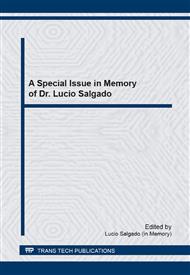p.167
p.172
p.178
p.184
p.190
p.199
p.204
p.210
p.215
Aluminum Coating Obtained through the Sol-Gel Method to Protect Metallic Surfaces against Corrosion
Abstract:
Before metallic materials are painted, surface pre-treatments are usually applied, these are known as conversion treatments. Such treatments aim to slow the degradation of the organic coating/metallic substrate system in aggressive environments. Amongst the most effective conversion coatings for aluminum and its alloys, is the chromatization. However, the high toxicity of this process waste has led industry to ban the chromatization process from the market and seek new procedures to protect metallic surfaces which, at the same time, present lower toxicity and are efficient to protect against corrosion. This study aims to obtain a coating composed of aluminum oxide on the Al AA 3003 alloy, as a potential method to substitute the chromatization process. A study on the protection properties against corrosion of the base metal, coated with oxide, was developed. Open circuit potential tests, electrochemical impedance spectroscopy, and anodic potentiodynamic polarization curves were carried out in a Na2SO4 0,5 molL-1 solution and pH 4,0. The morphology characterization was performed employing the scanning electronic microscopy (SEM). Results indicated that the new coating presented better behavior than the chromatized samples, suggesting that the former can substitute the chrome coating.
Info:
Periodical:
Pages:
190-195
Citation:
Online since:
September 2014
Keywords:
Price:
Сopyright:
© 2015 Trans Tech Publications Ltd. All Rights Reserved
Share:
Citation:


